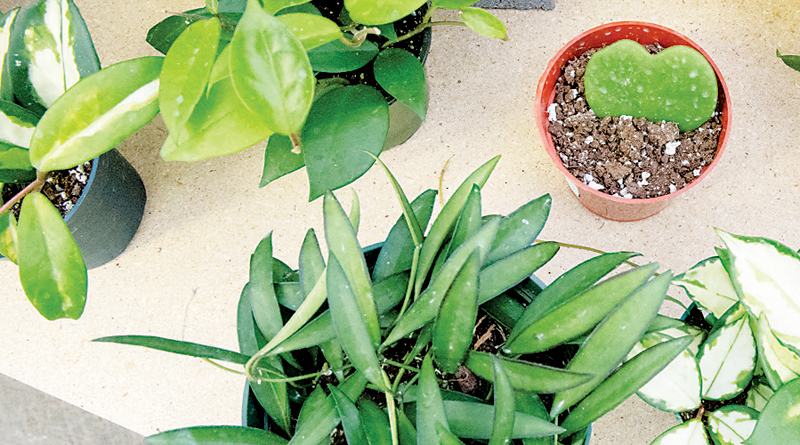HAVE YOU EVER GROWN A HOYA? – Green-Thumb Gardener

The hoya, or wax plant, has been sold as a house plant for many years but was not familiar to many people. With the current resurgence of interest in house plants, the hoya has become very popular and many more varieties are becoming available for purchase. There are over 200 species, many of which are only able to be differentiated by their flower. They are native to Australia and the eastern Asian countries.
Hoya plants are succulents with thicker, waxy leaves and clusters of star-shaped flowers. They vine and have sweet-smelling nectar. Some of the optimal growing conditions they require are:
– Rich, well-draining, loose soil that can allow air into the root area (too much water and not enough aeration makes them susceptible to root rot).
– Only water when the top inch of soil starts to dry out. Then water thoroughly and allow it to dry again.
– 60-80 degrees Fahrenheit ideal temperature with a minimum of 50 degrees
– Bright indirect light (can scorch/bleach in direct) at least 6 hours per day (tougher in our gray Indiana winters so a grow light could be helpful, especially if you want to achieve flowering)
– Higher humidity levels (again, tough to achieve in our Indiana winter-heated home environment). A humidity tray could be very helpful to their culture.
– Regular application of fertilizer during the growing months (mid-March through mid-September). A high nitrogen fertilizer is best in younger plants and as they mature using a fertilizer higher in phosphorus can help to promote blooming. Hoya plants go into a semi-dormant state (very little growing) during the winter months (mid-September through mid-March) generally, so fertilizer would not be helpful to the plant during that time and can actually be harmful with build-up of salts.
– Don’t be too quick to try to up-pot this plant. It performs better when it is a bit root-bound. When you must up-pot, remember to only do it during the active growing months and go only 2” larger in diameter than the pot it is currently in
– If you can achieve flowering from the plant, this is one of the plants you do not want to cut off the spent flower stock as new flower stems are likely to grow from it. Little pruning should be needed for the entire plant unless it has parts that are dead.
Visit your local garden center to check out this unique, low-maintenance plant!
This article is sponsored by McNamara at Sand Point, which has 2 acres of production greenhouses, retail florist and gift shop, as well as retail garden center and wholesale plant business. Contact McNamara by calling 260-747-4131 or visit 4322 DeForest Ave, Ft. Wayne, IN 46809.
- Celebrating 20 Years Of Community At The Stand - April 12, 2024
- First Positive Case Of Chronic Wasting Disease In Indiana - April 12, 2024
- Southwest Allen County Schools Embark On Major Tree Plantings - April 12, 2024


